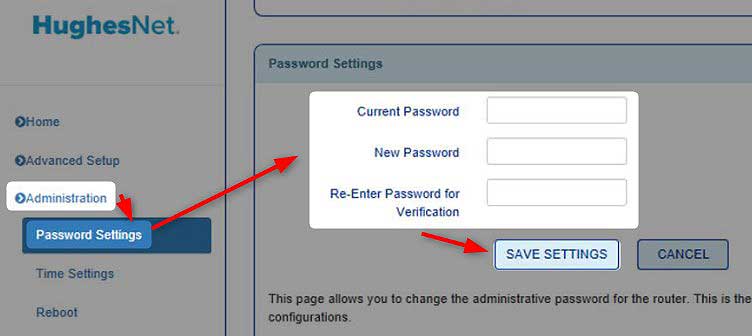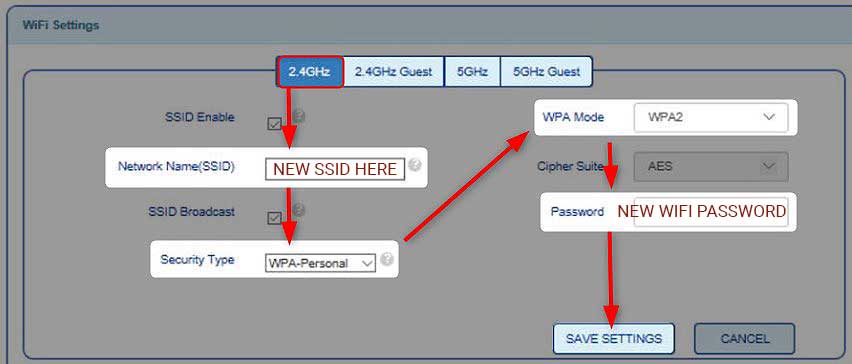Managing your HughesNet router settings can’t be done if you don’t know how to access the router admin dashboard. However, once you learn how to do it properly, you will be able to manage the router settings easily.
In the next few paragraphs we are going to explain how to access the HughesNet router setting on your computer, although you can access them using your smartphone or tablet. The process is the same.
CONTENTS
Before You Start
In order to make sure the Hughesnet router login to be successful we need to do something first:
1. Get a device like a computer or a smartphone to connect to the network and access the router settings
2. Connect your device to your network
3. Get the default or custom HughesNet router login details
Once you make sure you have everything you can proceed. But first let’s see what are the default HughesNet router IP address, admin username and password:
What Are The Default HughesNet Router Details?
HughesNet routers, just like most routers today have some default settings that make the initial router setup and configuration as easy as possible.
| Default router IP address | Default admin username | Default admin password |
|---|---|---|
| 192.168.42.1 | – | admin |
| 192.168.0.1 | admin | admin |
| 192.168.0.1 | – | admin |
How To Access The HughesNet Router Admin Dashboard?
The HughesNet router login process is pretty simple and if you have prepared all the things we have mentioned it shouldn’t take longer than a minute to access the admin dashboard.
So, let’s start!
NOTE: The screenshots below may look different depending on your ISP.
STEP 1 – Check If The Device Is Connected
If the device isn’t connected, you won’t be able to login. It’s that simple. So, take your device and connect it to the wireless network or if the device has a LAN port, connect it directly to the router with a network cable.
Once you confirm that the device is connected, you can proceed.
STEP 2 – Start The Web Browser On Your Device
Now launch the browser you already have installed on your device. It will help you access the router’s web-based interface. It is a user-friendly interface that allows the user to manage the router settings. It doesn’t require an active internet connection, but it is important that your device is part of the network. You can also use any of the popular browsers today, so you don’t have to think much about that too.
STEP 3 – Type The HughesNet IP In The Address Bar
Now, in the Address bar of your browser, enter the HughesNet router IP address. Type it carefully because you don’t want to make a typo here and also make sure you are typing numbers and dots only, no letters.
After you press Enter or Go on your device keyboard, you should be asked to enter a username and a password. It means that the IP is correct. However, in case the router login page doesn’t show up, you need to retype the IP and if it doesn’t appear again, check whether it is the right router IP. On Windows, open the Command prompt and type ipconfig. You will see the router IP address listed as Default Gateway. If you are using another operating system or a smartphone check this guide here.
STEP 4 – Enter The HughesNet Admin Password
When asked to enter the admin password, type the login details we have given at the beginning of this article. You can also check the label on the router and use those login details in case they are different from ours.

The password is case-sensitive so be careful. After you type it, click on Login and the router settings page will open. Now you have the possibility to modify the router settings. Since we have mentioned the default settings and how important it is to change it, here are the ones that have to be changed immediately.
How To Change The HughesNet Default Admin Password?
Changing the admin password is required although most people skip this step. This will prevent anyone on your network from accessing the router admin dashboard without your permission.
1. Login to your HughesNet router as described above.

2. In the left-hand menu select Administration.
3. Now click on Password Settings.
4. Enter the old password in the Current password field.
5. In the New Password field enter the new HughesNet admin password.
6. Now enter the new password again in the Re-Enter Password for Verification field.
7. Click on the Save Settings button to confirm the changes.
If you get logged out of the admin panel, login again and use the new admin password.
How To Change The HughesNet Default WiFi Name And Password?
The default network name and password have to be changed as well. The default network name can reveal the router brand which makes it easier for anyone to find the router IP and the default admin login details. It is also good to make the network name recognizable. As for the WiFi password, you have to make sure your wireless network is well protected with a strong password. It is also recommended to change this password every few months.

1. Access the HughesNet router settings.
2. The WiFi Configuration page will appear on the home screen. There you can see the current settings for both the 2.4 and the 5GHz network. Let’s say we have selected the 2.4 GHz network.
3. Select the WiFi network you want to modify and enter the new network name in the Network Name (SSID) field.
4. As a Security Type select WPA2-Personal.
5. Set the WPA Mode to WPA2.
6. In the Password field enter the new wireless password.
7. Click on the Save Settings button.
7. You can repeat all these steps for your 5GHz network and your guest networks if you have enabled them.
In case you are disconnected from the network, connect again to the new WIFi name and use the new WiFi password. If you have connected your device using a network cable, this won’t happen. But you will need to reconnect your wireless devices again.
Recommended reading:
- How to Speed Up HughesNet Internet? Read This First
- My HughesNet Internet Is Not Working (Quick Tips on Getting Your Internet Connection Back)
- Hughesnet System Light Off: Here’s What to Do
Final Words
HughesNet routers will definitely provide reliable and fast internet connection. And if you know how to secure that internet connection and manage the router settings, even better. We hope that this article was helpful and that you have managed to login successfully. Also, securing the router by making two simple changes is something you should definitely take care of. And if you want to make some additional changes to boost your network security feel free to go through our website and find the tutorials you are interested in.

Hey, I’m David. I’ve been working as a wireless network engineer and a network administrator for 15 years. During my studies, I also worked as an ISP field technician – that’s when I met Jeremy.
I hold a bachelor’s degree in network engineering and a master’s degree in computer science and engineering. I’m also a Cisco-certified service provider.
In my professional career, I worked for router/modem manufacturers and internet providers. I like to think that I’m good at explaining network-related issues in simple terms. That’s exactly what I’m doing on this website – I’m making simple and easy-to-follow guides on how to install, set up, and troubleshoot your networking hardware. I also review new network equipment – modems, gateways, switches, routers, extenders, mesh systems, cables, etc.
My goal is to help regular users with their everyday network issues, educate them, and make them less scared of their equipment. In my articles, you can find tips on what to look for when buying new networking hardware, and how to adjust your network settings to get the most out of your wi-fi.
Since my work is closely related to computers, servers, and other network equipment, I like to spend most of my spare time outdoors. When I want to blow off some steam, I like to ride my bike. I also love hiking and swimming. When I need to calm down and clear my mind, my go-to activity is fishing.

thank you with this article, however i tried both the password on the panel of the router and the default password but it keeps saying wrong pasword, how do i reset my administrative pasword